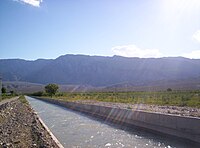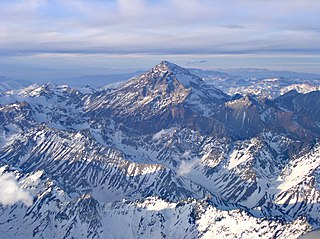
Mendoza, officially Province of Mendoza, is a province of Argentina, in the western central part of the country in the Cuyo region. It borders San Juan to the north, La Pampa and Neuquén to the south, San Luis to the east, and the republic of Chile to the west; the international limit is marked by the Andes mountain range. Its capital city is the homonymous city of Mendoza.
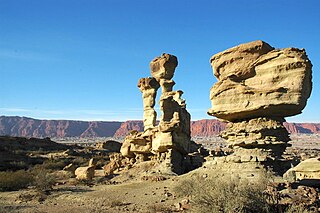
San Juan Province is a province of Argentina, located in the western part of the country. Neighbouring provinces are, moving clockwise from the north, La Rioja, San Luis and Mendoza. It borders with Chile to the west.
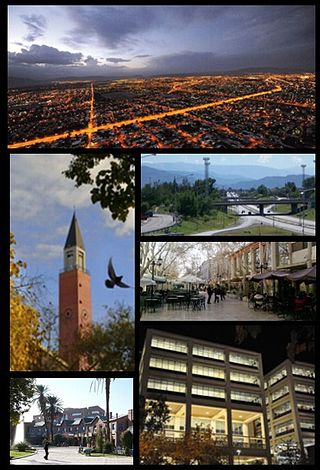
San Juan is the capital and largest city of the Argentine province of San Juan in the Cuyo region, located in the Tulúm Valley, west of the San Juan River, at 650 m (2,133 ft) above mean sea level, with a population of around 112,000 as per the 2001 census [INDEC].

Cuyo is the wine-producing, mountainous region of central-west Argentina. Historically it comprised the provinces of San Juan, San Luis and Mendoza. The modern New Cuyo includes both Cuyo proper and the province of La Rioja. New Cuyo is a political and economic macroregion, but culturally La Rioja is part of the North-West rather than of Cuyo.

Argentina is the fifth largest producer of wine in the world. Argentine wine, as with some aspects of Argentine cuisine, has its roots in Spain. During the Spanish colonization of the Americas, vine cuttings were brought to Santiago del Estero in 1557, and the cultivation of the grape and wine production stretched first to neighboring regions, and then to other parts of the country.
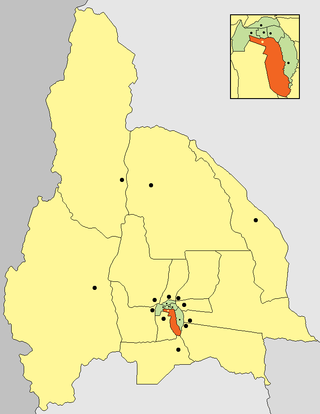
Rawson is a central department of San Juan Province in Argentina.

Sarmiento is a department located in the south west of San Juan Province in Argentina.
Villa Aberastain is an Argentine city of the province of San Juan, head of the department Pocito, and the headquarters of the municipal authorities of the department. Villa Aberastain is within the so-called Valley of Tulum, the main agricultural oasis in the province is concentrated and where 90% of the provincial population. The village is located about 15 kilometres from the low foothills of the Great St. John. National Route No. 40 passes a few kilometres east of the town and communicates with the provincial capital and the city of Mendoza.

Rivadavia is a department of the province of San Juan (Argentina). Located in the central southern part of Argentina, in the northeast section of the Valle del Tulum The city of San Juan is located in the west of this region, which is part of the conurbation, Grand San Juan. It is the capital city of the department of the same name, and is the government seat. It has various municipal edifices, including the police headquarters, and an important hospital, Marcial Quiroga.

Zonda Department is an administrative department of San Juan Province in Argentina. Zonda is located in the south of the province, bordered by Ullum Department to the north, Sarmiento Department to the south, Calingasta Department to the east, and Pocito Department and Rivadavia Department to the west.

Caucete is a department in the eastern part of the San Juan Province of Argentina, which is predominantly a landscape of mountains, and many plantations. It contains the popular Shrine of the Difunta Correa.

Nueve de Julio is a department of Argentina, located in the south-center of the province of San Juan. Lying within the Tulum Valley agricultural oasis, almost 80% of the department's area is cultivated; it is known in particular for its production of wine and its fruit and vegetable crops.

Jáchal is a department of the province of San Juan (Argentina). It is located north of the same by making, characterized by its first level agricultural production, which emphasizes the planting of onion. The city is also known as the cradle of tradition.
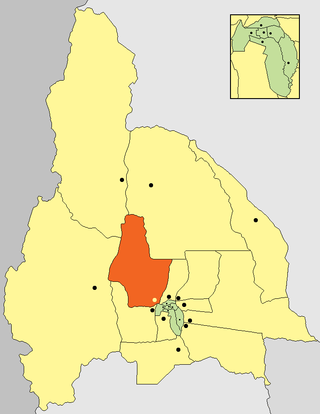
Ullum is a department of the Argentinean province of San Juan. It is located in the center of the province and its landscape is dominated by mountains and low vegetation. Its seat is Villa Ibáñez. It is also characterized by the production of grapes and fruit. The San Juan River is dammed by the Ullum Dam.
The National Day of the Sun is an annual celebration of nature that takes place in the City of San Juan and other locations in the San Juan province, Argentina, usually during the month of February. It gives a sample itinerary of economic activities, customs, characters and historical events of the province. It also highlights include a beauty contest, which elects the National Queen of the Sun and the Sun Virreina, candidates representing each of the nineteen departments of the province. The queen is chosen, and eventually Virreina, representing the province for one year, attending to other provincial and national holidays as well as tourism fairs and events to promote the province.
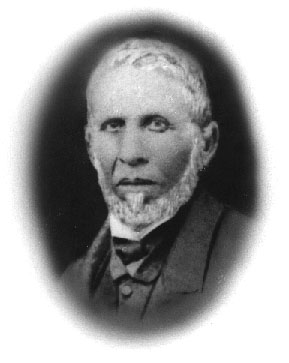
José Santiago Albarracín 1 was an Argentine soldier who fought on the Unitarian side in many engagements in the Argentine Civil Wars, especially in the struggles against Chacho Peñaloza.
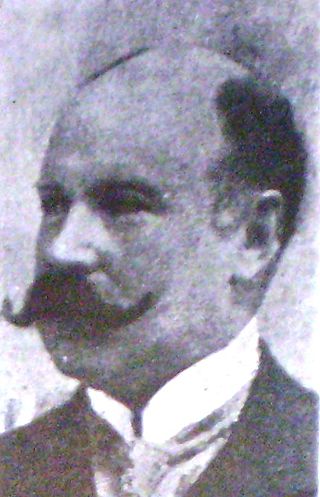
Saturnino María Laspiur was an Argentine lawyer and politician who served as deputy, senator, Minister of the Supreme Court of Justice and Minister of the Interior of his country.
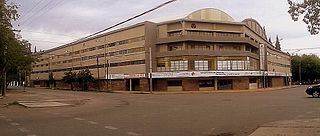
The Estadio Aldo Cantoni is an arena located in the city of San Juan, capital of San Juan Province. Inaugurated in July 1967, it is mainly use by local clubs UPCN and Obras Pocito for their home matches for the Serie A1, the top level of the Argentine men's volleyball league system.

Sergio Uñac is an Argentine politician who serves as governor of the San Juan Province.

The Espinal (NT0801) is an ecoregion of dry, thorny forest, savanna and steppe in Argentina. It has been extensively modified by large scale cattle ranching, but remnants of the original flora remain. It is threatened by the advance of the irrigation-based agricultural frontier.



